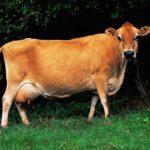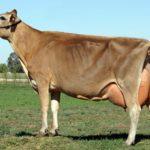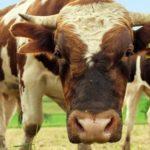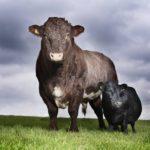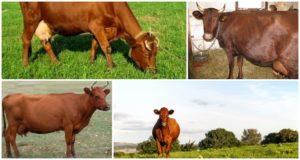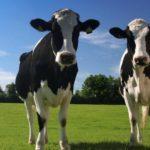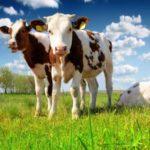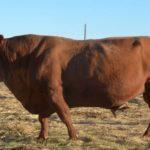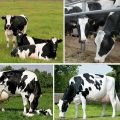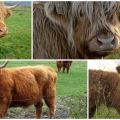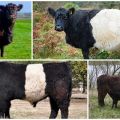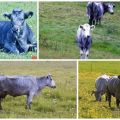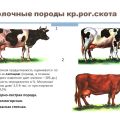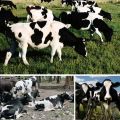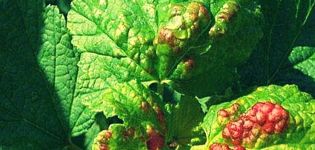Types and colors of cows in Russia and the world, what cattle looks like, characteristics of breeds
Until the 17th century, the wild bull tour, the ancestor of modern cattle, roamed the steppes of Eurasia and the African continent. Domesticated animals have been known since the eighth century BC. In agriculture, female domestic bulls are called cows. They serve as the main source of milk and meat. Depending on the direction, dairy, beef and mixed breed of cows are distinguished.
General description of the animal
Cattle belongs to mammals, cloven-hoofed animals of the bovine family. Females become cows after the first calving and lactation. From birth to puberty, they are called heifers, and after the onset of the first pregnancy, heifer.
Appearance:
- growth at the withers - 1.2-1.5 meters;
- birth weight - 18-45, sometimes 60 kilograms, depending on the breed;
- the average body weight of adult animals is 750 kilograms;
- the minimum weight is 145 kilograms, the maximum weight is more than a ton;
- the body is elongated, with a concave or straight back;
- the coat is short or long, monophonic, piebald;
- the pelvic bones are thick and protrude on both sides of the tail;
- the tail is thin, with short hair, reaching the hooves;
- the end of the tail is covered with a long bristle brush, with which the cow drives away insects;
- legs straight, thin or muscular, hind pair set wide apart;
- wide neck;
- the head is elongated, tapering towards the nose;
- the forehead is wide, flat, covered with curly hair, with a straight forelock or open;
- the horns are short, long, straight or bent upward at the ends, absent in some breeds;
- the eyes are located on the sides of the head, the pupil is horizontal;
- the ears are oval, flat, velvety on the outside and covered with long hair on the inside.
Cows are black, white, gray. Animals that are completely reddish are called red. Spotted coloration is considered typical - white markings on a dark background and black on white, highlighted by white hair on the neck, belly, hooves or tail.
Cow spots are a genetic mutation resulting from domestication. In wild animals, the color is only monochromatic. Among domestic breeds, a monochromatic color is also common, usually brown, with a white star mark on the forehead.
Life expectancy of cows is 20 years. Sexual maturity occurs at 10 months. They are ready for mating at 18 months. Pregnancy lasts 8-9 months. After the first calving, colostrum appears, which the calves feed on. To obtain milk, cows are milked 2-3 times a day. The lactation period lasts 8-11 months.
Cow classification
Distinguishing cows by physique was first proposed by the Russian zootechnician P.N.Kuleshov at the beginning of the 20th century. He proved that with the enhanced development of one system of the body of a pet, others are oppressed. With a developed skeleton and skin, internal organs and muscles are usually depressed. Muscle development inhibits the growth of bones and hair.

According to Kuleshov's classification, cows are of four types:
- rough - powerful bones, muscles, thick skin, large horns, little fat;
- delicate - thin skin, gathered in small folds at the udder and on the neck, veins and bones appear on the surface, the development of internal organs prevails over muscles;
- loose - excessively developed fatty layer under the skin and on the internal organs, which negatively affects the overall development;
- dry - strong veins, good blood circulation and digestion promote hair growth and milk production.
The four main types are intermingled. For example, in animals, traits of a gentle and loose or gentle and dry type are combined.
According to external signs, the following areas of cattle productivity are distinguished:
- meat - characterized by a rough and loose constitution, a quick set of muscle and fat mass;
- dairy - animals of a delicate dry constitution, high milk yield is achieved due to the digestion of a large amount of food and active blood circulation in the udder;
- mixed - combines the characteristics of a rough and dry type, quickly builds muscle mass and gives a lot of milk.
The meat and milk type has exterior disadvantages that reduce the value of meat: due to the deflection of the back, the amount of pulp decreases, there is no fat layer in the meat. Purely beef cows produce marbled meat with thin strips of fat. Mixed cattle are often raised for milk production. Classification of domestic cows by origin:
- pedigree - bred by selective selection;
- mongrel - animals without signs of belonging to a particular breed, local livestock;
- decorative - with an unusual appearance, bred for beauty.
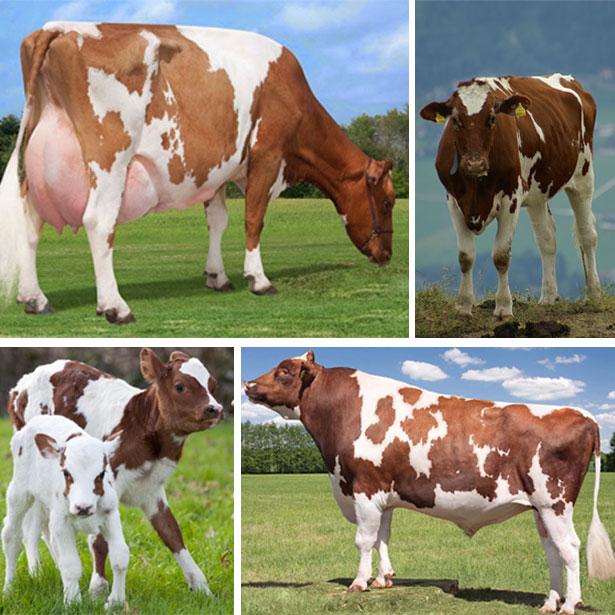
According to the length of the coat, short-haired and curly breeds are distinguished. Felt and felt boots are made from cattle pile.
Popular cattle breeds
Over the centuries-old history of agriculture, more than three hundred breeds of domestic cows have been bred. Local economic, draft animals and foreign thoroughbreds were crossed. As a result, new varieties were obtained with improved indicators of milk or meat productivity, more adapted to life in a harsh climate and unpretentious in nutrition.
Dairy direction
Among domestic breeds, the most popular are:
- Holstein;
- jersey;
- Ayrshire;
- dutch;
- brown Latvian;
- Tagil;
- red steppe.
From one cow get 4500-7000 liters of milk per year. Aboriginal breeds are famous for high milk yield:
- palsho;
- Yakut;
- Carinthian;
- Ukrainian gray.
Cows are called aboriginal, which have been raised since ancient times in different countries of the world. They also include the red steppe, which is popular in Kazakhstan. The Mongolian breed was raised by the inhabitants of medieval Central Asia - the Dzungars.
Meat breeds
General characteristics of beef cows:
- muscularity;
- massiveness;
- small udder.
They give milk, but in limited quantities, for posterity.
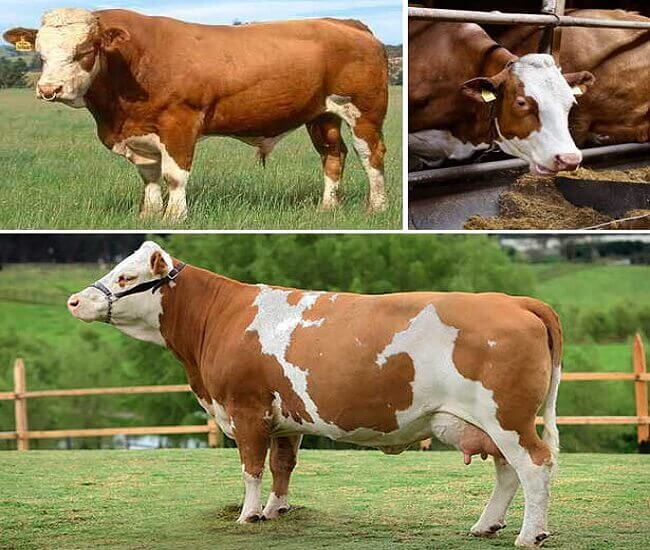
Popular types of beef cattle:
- hereford;
- Aberdeen Angus;
- Charolese;
- limousine.
The Belgian Blue and Piedmont breeds show a large increase in mass.Cows are distinguished by giant raised muscles that stand out under the thin skin. Muscle hypertrophy has developed as a result of a genetic mutation.
But the meat of cows is tender, without fatty streaks, with a high protein content.
Dual use
Mixed cattle breeds differ from meat and dairy breeds in their versatility. They produce high volumes of milk and show rapid weight gain. One of the indicators may prevail. Popular mixed breeds:
The volumes of milk dispensed per year are 3500-5000 liters. When fattening, the weight reaches 1500 kilograms, and 65 percent of the carcass is used for sale. Mixed cows produce marbled meat without veins. Curly-haired highlands are also ranked as a mixed direction. The Scottish breed produces low-cholesterol meat, rich in iron and protein, and improves meadow health.
Calf, bovine and cow leather is used in the production of outerwear, shoes, gloves and haberdashery.
Rare and decorative
Some cattle breeds are notable not for performance indicators, but for the size of the horns, color or miniature size. The main ones are:
- Dexter is the smallest breed in Europe, originally from Ireland. Height does not exceed a meter due to short legs;
- galloway - called belted, as the dark torso traces a white stripe across; bred in Scotland;
- Texas Longhorn - their horns are 1.8 meters long, reddish-white, used for riding;
- plush - decorative cows were bred in the US state of Iowa, fluffy calves look like toy;
- Highland - Scottish cows with long hair belong to the meat industry, thick bangs protect the eyes from rain and snow;
- watussi - African red cows with huge arched horns; refer to dual orientation;
- The White Shorthorn is an elite British beef breed that is on the brink of extinction.

The smallest cow in the world is the sacred Indian zebu. In adulthood, it reaches the size of a commercial calf.
What breeds are popular in Russia
The choice of varieties of cows that are bred in our country is due to unpretentious care, adaptability to temperate and northern climates and high productivity.
The most popular breeds, their description and orientation are shown in the following table:
| Breed name | Characteristic | Direction | Performance |
| Jersey | Compact, angular, with a flat body and protruding pelvic bones. The color is brown with white markings and a black mask on the eyes and nose. | Dairy | 6500 liters of milk per year |
| Ayrshirskaya | Proportionally folded, with upturned horns, easily acclimatized, tolerates pasture well. | Dairy | 7000 liters of milk per year. The weight of cows is 480 kilograms, bulls - 800 kilograms. Lethal exit - 50 percent |
| Hereford | Broad body, rounded sides, soft short coat, red-white color | Meat | The weight of the bulls is 1000 kilograms, 70 percent of the carcass is to be sold. Milk yield - 1200 liters per year. |
| Yaroslavl | Thin limbs, developed muscles, wide pelvis, black and white color. Low forage consumption, disease resistant | Dairy and meat | The weight of the bulls is 1200 kilograms. The yield after slaughter is 58 percent. The annual milk yield is 6,000 liters. |
| Kholmogorskaya | Large, broad-chested, with crooked hind legs. The color is black with white markings. Well adapted to cold climates and do not tolerate heat well. | Meat and dairy | The cows produce 4000 liters per year. The weight of the bulls is 1000 kilograms. Lethal output - 60 percent. |
In Russia, the most common dairy and mixed breeds. They maintain high productivity in the presence of dietary deficiencies.
Meat breeds require large amounts of succulent feed all year round. Diet deficiencies negatively affect weight gain.
Selection recommendations
The direction of the cow can be determined by external signs. Large, bowl-shaped udders with swollen veins indicate high milk production. A dense build, straight back and small udder are signs of a meat breed. When choosing a dairy cow, it is important to consider her age. High productivity is observed from two to six years. To check the age of a cow, look at her teeth. From the age of five, the incisors begin to wear off. The more they are erased, the closer the animal's age is to ten years. In older cows, gaps are visible between the teeth.
It also matters what kind of lactation is going on: milk yield grows from the second to third, and decreases from the fifth. Before buying, you need to check the quality and fat content of the milk. The color of the cow does not affect productivity, but it is also one of the selection criteria.
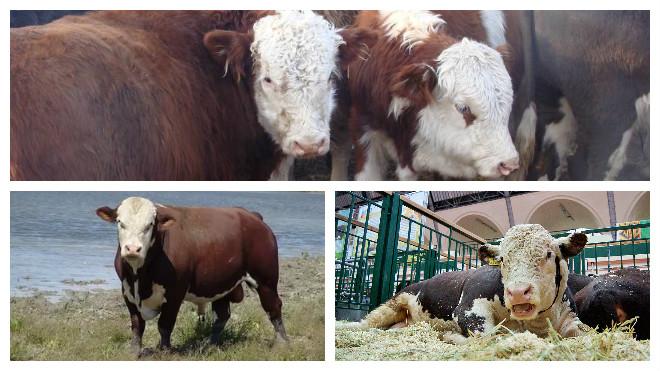
The names of the main colors:
- the black;
- white;
- brown;
- Dark red;
- yellow.
Cow breeds are distinguished by color and constitution. For example, the white Shorthorn can be easily distinguished from the Jersey variety, which is characterized by its red color. Important criteria when choosing beef breeds are fatness and fattening ability. In a well-fed animal, the skin is well pulled, and a fat layer is felt under it, and in a starving animal, it does not fold. Animals with a short, wide body, thin bones and thick skin are prone to rapid weight gain.
When examining a cow, attention is paid to its character. If the animal is calm and interested in a stranger, it will be easy to look after him. It is difficult to approach a restless cow to milk. It can strike dangerously with a hind hoof. Well-groomed appearance speaks about the health and high productivity of cattle. In the absence of regular cleaning, cows' milk yield decreases.







